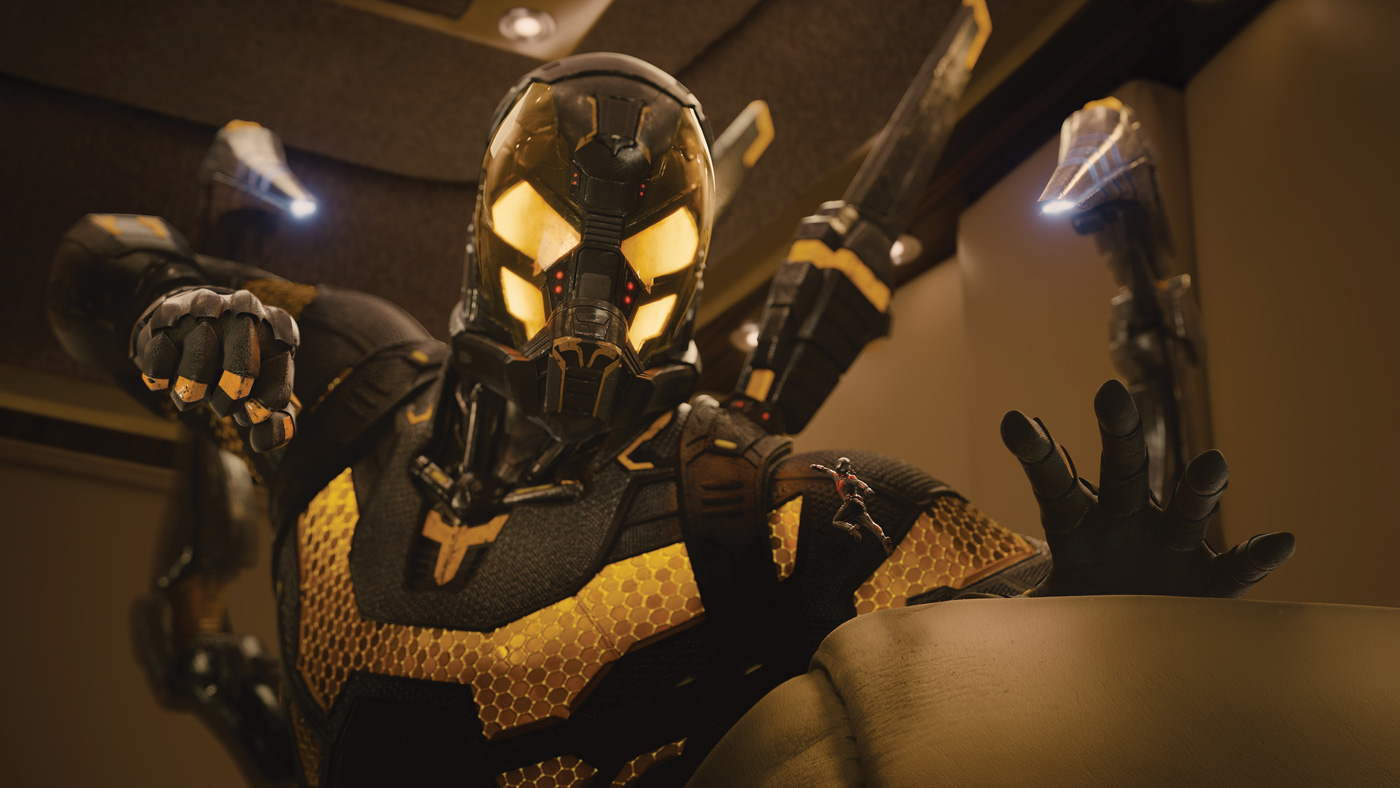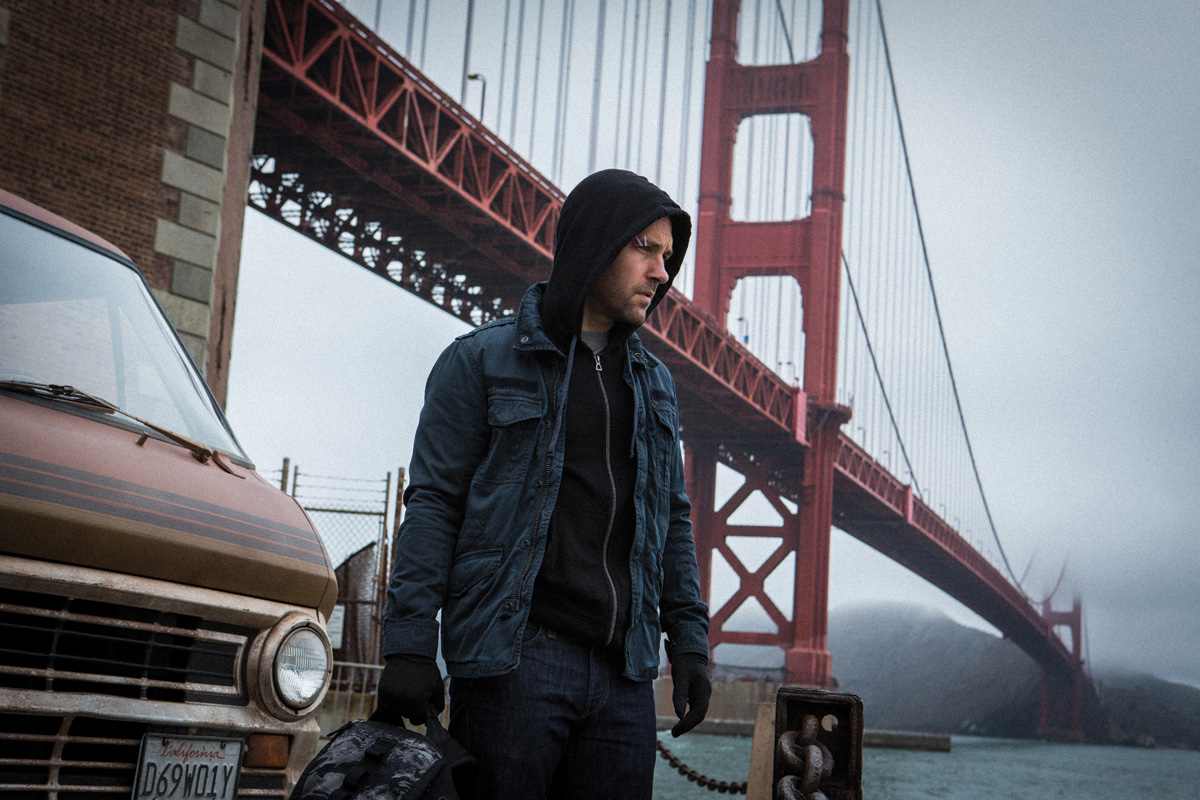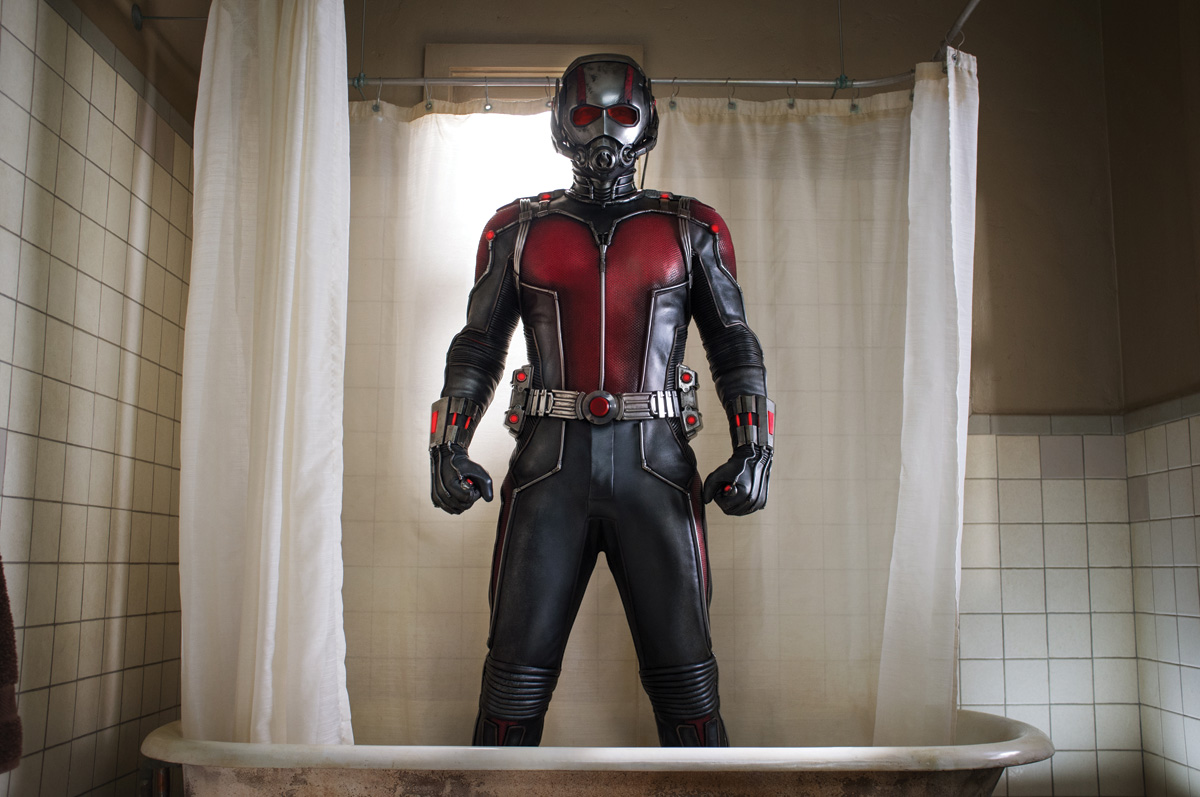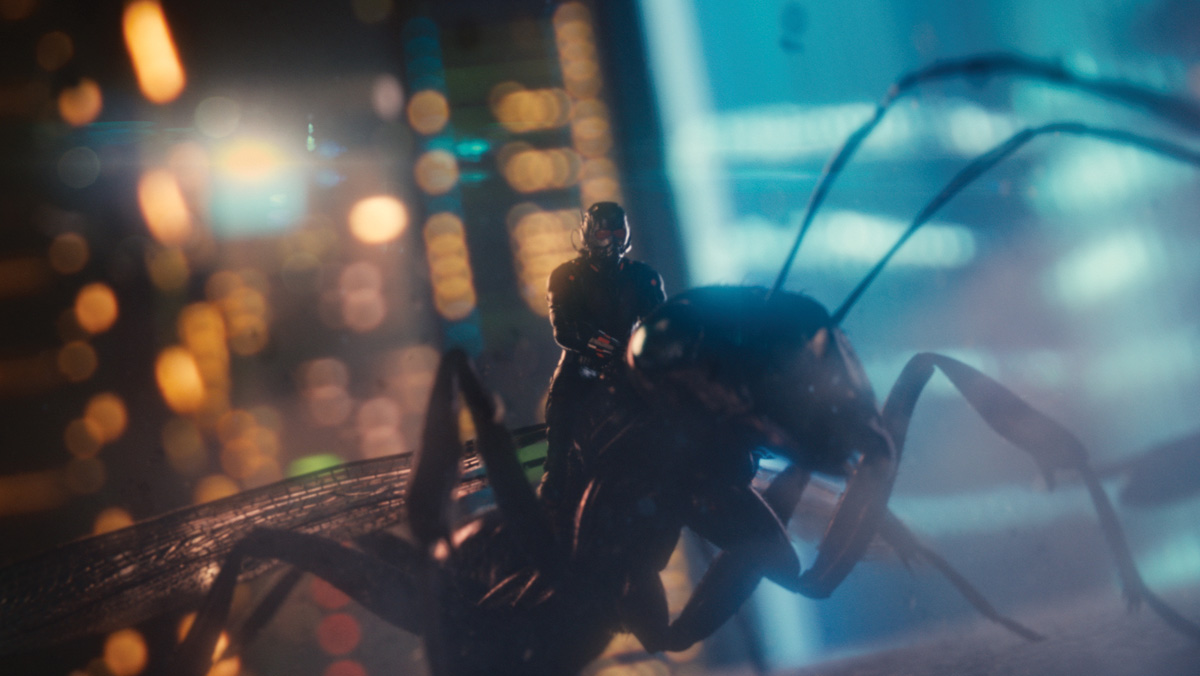Russell Carpenter, ASC, joins the Marvel “colony” for its latest page-to-screen hero, the mighty, tiny Ant–Man
Concluding Phase Two of the Marvel Cinematic Universe (MCU) rollout, Ant-Man travels a road not taken, and a hero not even visible to the naked eye. Dr. Hank Pym (Michael Douglas), a biophysicist who years ago discovered a means to miniaturize himself, recruits industrial thief Scott Lang (Paul Rudd) to engage in some well-intentioned law-breaking, which serves as a kind of awakening for Lang.
Filmmaker Peyton Reed, who stepped in to replace Edgar Wright as director late in preproduction, describes Lang as a “street-level guy who may be the character you can most relate to in the MCU. He doesn’t have superpowers and has made his share of bad decisions, but the suit and the powers it contains give him a new chance at things.”
ICG talked to Ant-Man’s key contributors, including Reed, cinematographer Russell Carpenter, ASC, and production designer Shepherd Frankel, to reveal how they expanded the MCU from such a wee, tiny source.
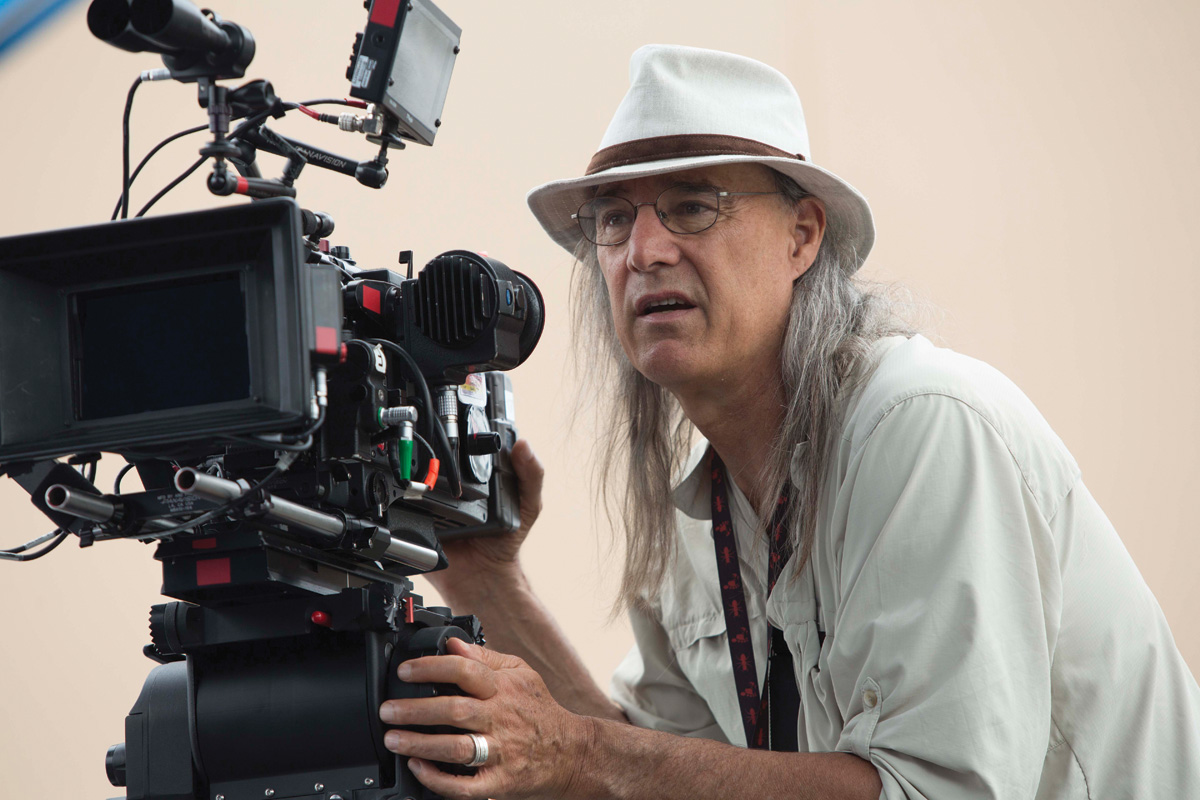
Preproduction: Too Short a Season
Reed: Ant-Man was already a bullet train when I came onboard. I worked with writers on a new draft while poring over all existing artwork and builds, trying to proceed with the greatest efficiency in the time we had left. I wanted to do a 2015 version of a shrinking movie, so the whole notion of building giant Rudd-sized pencils wasn’t going to fly because you’d see brush strokes and all these giveaways that didn’t represent the reality of the macro-world, which we’d seen in amazing detail way back on Phase IV, where director Saul Bass showed how ants come to visual life when you see their translucency up close. With the goal of being immersive and photorealistic, we utilized motion picture macro-cinematography, augmented with still photography of these genuinely tiny landscapes that were tiled together for CG environs.
Russell Carpenter: After going over the existing boards, Peyton saw there were useful elements and decided it didn’t make sense to jettison everything that had been done before, so he kept those storyboarded sequences that supported his personal vision for Ant-Man. I looked at the sets to see what could be done with respect to lighting, and production designer Shepherd Frankel worked with my gaffer Len Levine to introduce improvements. We had armies of people deployed to get things ready in time, since the release date hadn’t slipped.
Shepherd Frankel: The first big question was how do we make this into an amazing visual experience in just ten weeks? And getting 3D models to Peyton so he could plan his staging and camera was a big part of our early effort. The film community continues to make an effort at recycling, and in the Marvel universe there’s both opportunity and good reason to do this, helping to maintain visual cohesion. There was a warehouse location that is already part of the MCU history, so we included some existing Marvel assets there. It’s more an Easter egg than story-significant, as this particular film didn’t have a lot of crossover. Hank Pym had developed Ant-Man technology in a place and time that allowed us to contrast how his tech was being used today, which created more visual interest.
Reed: Better than anybody else right now, Marvel takes the essence of the comics and adapts that to the very different medium of film without sacrificing what made it worthwhile in the first place. A very literal translation doesn’t necessarily fly when translating to live-action and three dimensions, so this knack is a real boon to credibility. They also have an established aesthetic to which they adhere, but they are not enslaved by it, and they welcome outside input that embellishes upon it. Marvel Studios’ head of visual development Ryan Meinerding refined all the basic designs for the Ant-Man and Yellowjacket costumes, and then my visual ideas for this film got incorporated as part of the MCU aesthetic.
Frankel: Scott’s journey starts in greasy alleyways and tenements of San Francisco’s Tenderloin [realized via a short location shoot in the Bay Area before production settled in at Pinewood Atlanta Studios] and winds up in the high-tech Pym lab with its immense level of detail. How a room feels and is lit goes hand-in-hand with the production design. So Russ and his gaffer, Len Levine, helped get me there with built-in lighting – which includes lighting changes, depending on mood and events. The backgrounds largely light themselves so Russ can focus on lighting the talent.
Carpenter: Shepherd understood my concerns about not wanting to shoot straight into a wall, that I preferred shooting in-depth. So he added doorways and windows that let the camera see beyond, increasing visual interest and production value.
Production: Rising Up
A-Camera Operator Peter Rosenfeld, SOC: I’ve operated for Peyton on all his movies, so there’s shorthand in terms of framing and camera movement. This was a very large production with many units filming at the same time. First unit was mostly about performance and any centerpiece action Peyton wanted to direct. Given the time constraints, we sometimes would only establish a key moment or sequence, and then second unit would complete the coverage. We shot 1.85 on Arri Alexa XT and M cameras, using the M for fight sequences and helicopter filming. Russell selected Panavision spherical Primo lenses [14.5 to 150 mm] and the 11:1 and 4:1 zooms. We averaged about 3½ terabytes of data per day, recording to internal Codex packs that gave us a 4K image (in real terms, 3.8K.) Russell and Technicolor created a show LUT that was applied to all on set footage. This LUT was about ½ to 1 stop darker. In order to have a suitable image for operators and assistants, we used a Rec.709 feed for framing and focus.
Carpenter: For a lot of recent comedies I’ve kept my LUTs kind of “Kodak” – saturated and upbeat. But this show needed something different that affected skin tones and the Ant-Man suit, which dates back to the 1980’s, so it looks a little run-down. What I loved about this LUT was how it allowed the costume to retain the color but took it from fire-engine red to something a little more weathered. I baked it in with a bit more falloff, a little deeper in the toe. If I needed to see something in that toe later on in the DI, I had assurance that the information was there in Arriraw and I could bring it up.
Rosenfeld: In order to incorporate Paul Rudd’s performance as Ant Man when he was in the macro world, we used a [Centroid] facial capture set up. The director called out story moments and Paul performed facial expressions that would later be composited on a CG Ant-Man. Paul would sit in a chair surrounded by a 5-camera array of Alexas. One camera was set up vertically while the others were horizontal with overlapping image areas, all set to record at 48 frames per second. This maximized resolution and provided 3D modeling for Paul’s performance. In this set-up, we would need to reload capture packs every 12 minutes and typically record 8 to 10 terabytes of data in two hours of set time!
Reed: We would always have as much visual reference as possible during mo-cap sessions, either key frames done by VFX or photographic reference, and I’d walk Paul through the environment, informing him of how it all laid out and the feel of being down there, like how the heat and intensity of a desk lamp would impact somebody at that size. In a more philosophical bent, we had ongoing conversations about what size the camera operator would be – would he shrink along with Scott? There wasn’t a right or wrong answer, as it really was dependent on circumstance. For example, when we had tiny Ant-Man on a bathroom tile floor in the bathroom, I wanted a shot moving down toward him that suggested our crane was miniaturized too. The natural imperfections of the move created a subliminal scaling effect that gave the moment some emotional heft.
Rosenfeld: In dealing with the transition from the real world to the macro one, we wanted the audience to get a sense of the unexpected. When the character suddenly shrinks, the camera lags for a moment – a kind of “What just happened?” – before I tilt down to reframe him in his small form. So there was a vérité element – “We’re as surprised as the audience!” – which we use a few times before the transition becomes commonplace. Russell and Peyton’s decision to shoot in 1.85 was a good call, since at 2.35 there’s insufficient height in frame to appreciate the vertical aspects of his going from standing full-size to falling through a crack in the floor. A [P+S Technik] Skater Scope [helped] get the lens down to Ant-Man level.
Macro Production:
It’s a Small, Small World
Frankel: It’s more visually interesting to depict things from Ant-Man’s point of view instead of seeing him from a normal perspective. But we wanted a realistic realization, not Honey, I Shrunk the Kids with its oversized set pieces. The textures for a 20-foot-tall screw or a giant gummy bear never have the proper tactile quality that a real small object has in the macro world, which in its own way is as otherworldly as an alien planet. You get some really exciting visual possibilities when figuring out what an architectural model looks like when riddled with bullet holes in slow motion, and how a teddy bear disintegrates when blown up. [Laughs.]
Carpenter: There is a real art to working at this scale. One inch off the ground is like fifteen feet in the air. From an ant’s perspective, you move four inches, to a human perspective, that’s a football field! And when moving the camera, vibration becomes a tremendous problem, requiring careful consideration. It required thinking a bit outside the usual VFX box before we realized an expert and artful Director of Photography from the world of commercial ‘tabletop’ photography was needed. Based on her reel, it was clear Rebecca had the chops to take this on.
Macro Unit Director of Photography Rebecca Baehler: We had renderings and previs, but until you actually get a lens where it needs to be, you can’t be certain of what you’re going to get. We had to rework things because no matter how careful the measurements, the looks and angles didn’t always translate. If there’s a crack on the floorboard, it is going to look like the Grand Canyon to an ant. I followed Russell’s lead in terms of using light to create mood, and we actually followed first unit chronologically, about a week behind. When they finished with a set, they’d break it down and bring the relevant portions to me on my stage. We might go from shooting a perspective looking up at the seemingly huge bedroom set to peering down inside something that looked like an ant tunnel, where only a light head could get in to project a shaft. So we’d find ourselves switching around from big Fresnels and 20Ks to working off the end of a piece of light ribbon. Sometimes it would be high-tech, then down to a flashlight and a piece of tin foil.
Carpenter: Sometimes all you see in macro work is a couple of light streak pools across the floor, while the rest of the setting just looks flat. Rebecca took liberties to make those spaces lively and interesting while still looking real; they always had some shape to them. I rarely if ever got over to her unit because we were all working so fast, but it wasn’t necessary, because in dailies I saw it was all turning out great.
Baehler: When we went to Ant-Man’s perspective, everything was supposed to look hyper-real, so crisp focus was essential. Fiber-optic lenses can be used in macro work, but the clarity isn’t all the way there for digital. The Frazier lens gave me depth of field and let me get really low to the ground. I could focus on a pinhead – the lens quality is very good. In the midrange and wide lenses, you can often achieve enormous depth-of-field, though some of the time I had to use motion control to carry infinite focus, bracketing separate focus passes. I had suggested motion control when I came on, as it also let us undercrank when depth of field was a concern. Running at two frames per second got two or three more stops out of the Alexa without our having to cook the set under hot lights.
We also wanted to capture the dramatic sense of atmosphere at his scale. There were lots of dust particles floating in the air, so we put in shafts of light to illuminate these drifting elements in-camera. If explosions needed to happen as Ant-Man ran through, our motion-control rig was timed to be where he needed to be, in close proximity to the squib. There were also some very tight situations where I couldn’t use the Frazier lens and had to use an Innovision Probe. Then there were times when we were limited to letting VFX shoot high-res stills that captured my lighting setup and letting them work from that for assembling the environment.
Postproduction/VFX: Seeing Is Believing
Rosenfeld: We recorded “open gate” to use the full sensor area, keeping the area around the reticle clear [so] VFX can take advantage of image area not used for presentation to clone and copy set pieces to cover wires or manipulate and reposition. That flexibility was important when you consider how many VFX shots there are between elements, wire removals, and burn-ins.
Frankel: VFX supervisor Jake Morrison and his producer Diana Giorgiutti facilitated compositing all those macro environments – which usually ranged from 4-by-4 to 8-by-8 feet in size – making sure they nestled into our live-action sets and locations.
Carpenter: Working with VFX supervisors always gives me fresh perspectives on lighting. When your star appears small, you have to take extra care with light to shape him. Sometimes we provided interactive light but didn’t go too heavy with that because Jake asked for just a flash of interactive to let him see how the shadows play across the environment. Then there are situations where the character is so small, he is going to be animated, but even then Jake would have Paul Rudd perform the action, in either the Ant-Man costume or the motion-capture suit. Animation was derived from Paul, not as a blue-sky CG human or from a stunt performer with different body movements.
Reed: Even though we had calculated what the “real” depth of field should be beforehand, that estimate had to go out the window some of the time on macro shots, which got adjusted on a shot-by-shot basis during post, sort of like the “shrinking camera operator” issue.
Carpenter: Most of your shots in a Marvel film go through some kind of augmentation – even the skies wind up getting replaced by more dramatic vistas. But this show wasn’t about space drones from another galaxy, so working in a recognizable version of this world was absolutely the correct creative call, and supported by VFX. I have heard of pictures that get timed with a bias toward the changes introduced through VFX, but Jake was very up-front about wanting to respect our intentions, and made a point of color correcting before the VFX were added, so there wouldn’t be any surprises in the DI. I’m working closely with Steve Scott, a brilliant Technicolor colorist [Birdman, Gravity, Avengers: Age of Ultron] to mold the final look. Steve loves to help ‘find the story’ within each sequence and can add nuance with subtle color and contrast tweaks.
Reed: We did two days of reshoots in April. Normally when you shoot a movie you have to beg and scrape to get money for reshoots. But all Marvel movies schedule times in actor contracts for reshoots. It helps you as a director because you don’t have to hesitate about cutting a scene, knowing you can add some connective tissue, and also not having to resort to some over-the-shoulder ADR to cover your new transition.
Carpenter: Before starting Ant-Man, I had come back from doing a small movie in India called Parched. The crew there had been great but resources were very limited, so I used simple solutions that I hoped would prove elegant. Then I’m back here, and we have everything right at hand. But, amazingly, Ant-Man had a lot of the same joy and energy as the set of a small independent feature. I think its atmosphere is created from the top down. [Marvel Studios President] Kevin Feige is so jazzed about doing these shows that he just wants to share his joy; and that helped make a very large show feel intimate, like a few people in a garage making a film.
by Kevin H. Martin
Unit photos by Zade Rosenthal
Frame Grabs Courtesy of Walt Disney Pictures

